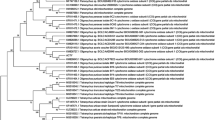Abstract
Toxicological responses to 10 different pesticides were determined for 3 species of typhlodromid mites,Typhlodromus pyri Scheuten,Amblyseius potentillae Garman, andA. bibens Blommers, in order to investigate whether or notA. bibens might be used as a substitute for the 2 other species as a testing object for measuring adverse effects of pesticides.
T. pyri andA. potentillae are important predators in orchards on phytophagous mites. These species can be reared on the common spider mite,Tetranychus urticae Koch, but they seem averse to the webbing of the spider mite. When placed on detached bean leaves on moist cotton wool withT. urticae present as prey, these typhlodromids tend to run off the leaves, especially when in addition such leaves have been treated with pesticides.A. bibens on the other hand will stay on the leaves when prey is present; it seems to be attracted by the webbing of the spider mite. This makesA. bibens an attractive testing object. In the present study the 3 species mentioned were tested comparatively in closed cells to see whether or not there might be differences in intrinsic susceptibility to pesticides. Mortality of adults, the effect on reproduction, and the mortality of eggs and juveniles were determined. It was found thatA. bibens can reasonably well replace other typhlodromids as a testing objeot for obtaining information on adverse effects of pesticides in orchards.
Résumé
Les effets toxiques de 10 pesticides sur 3 espèces de typhlodromes,Typhlodromus pyri Scheuten,Amblyseius potentillae Garman etA. bibens Blommers ont été examinés afin de déterminer si on peut employer ou nonA. bibens à la place des 2 autres espèces en tant qu'espèce test pour la mesure des effets nocifs des pesticides.
t. pyri etA. potentillae sont d'importants prédateurs d'acariens phytophages en vergers. Ces espèces peuvent être élevées sur l'acarien commun,Tetranychus urticae Koch, mais présentent des réactions de répulsion à la soie de ce tetranyque. Placés sur des feuilles de haricot plantées dans du coton humide avecT. pyri comme proie, ces typhlodromes ont tendance à quitter les feuilles, surtout si elles ont été traitées par des pesticides.A. bibens, par contre, demeure sur les feuilles en présence de la proie et semble attiré par le tissage de l'acarien. Ce fait rend intéressantA. bibens.
Dans ce travail les 3 espèces ont été étudiées comparativement dans des cellules fermées, afin de montrer si elles font preuve de différences dans leur sensibilité intrinsèque aux pesticides, d'après la mortalité des adultes, la reproduction et la mortalité des œufs et des jeunes. On a trouvé queA. bibens peut très bien remplacer les autres typhlodromes comme espèce-test.
Similar content being viewed by others
References
Bartlett, B. R. — 1964. The toxicity of some insecticide residues to adultAmblyseius hibisci, with a compilation of the effects of pesticides upon phytoseiid mites. —J. Econ. Entomol., 57, 559–563.
Blommers, L. &Van Etten, J. — 1975.Amblyseius bibens [Acarina: Phytoseiidae] a predator of spider mites [Tetranychidae] in Madagascar. —Entomol. Exp. Appl., 18, 329–336.
Coulon, J. &Barres, P. — 1976. Étude de laboratoire concernant la toxicité des produits phytosanitaires pourPhytoseiulus persimilis. —Bull. SROP/OILB, 1976/4, 45–63.
Croft, B. A. &Jeppson, L. R. — 1970. Comparative studies of four strains ofTyphlodromus occidentalis. II Laboratory toxicity of ten compounds common to apple pest control. —J. Econ. Entomol., 63, 1528–1531.
Croft, B. A. &Nelson, E. E. — 1972. Toxicity of apple orchard pesticides to Michigan populations ofAmblyseius fallacis. —Environ. Entomol., 1, 576–589.
Croft, B. A. &Stewart, P. G. — 1973. Toxicity of one carbamate and six organophosphorus insecticides to OP-resistant strains ofTyphlodromus occidentalis andAmblyseius fallacis. —Environ. Entomol., 2, 486–488.
Dosse, G. — 1957. Arbeitsmethoden zu morphologischen und biologischen Untersuchungen von räuberischen Milben. —Z. Angew. Entomol., 40, 155–160.
Downing, R. S. &Moilliet, T. K. — 1972. Replacement ofTyphlodromus occidentalis byT. caudiglans andT. pyri after cessation of spray on apple trees. —Can. Entomol., 104, 937–940.
Huffaker, C. B., Van de Vrie, M. &McMurtry, J. A. — 1970. Ecology of tetranychid mites and their natural ennemies. II. Tetranychid populations and their possible control by predators: an evaluation. —Hilgardia, 40, 391–458.
McMurtry, J. A., Mahr, D. L. &Johnson, H. G. — 1976. Geographic race in the predacious mite,Amblyseius potentillae [Acari: Phytoséiidae]. —Int. J. Acarol., 2, 23–28.
McMurtry, J. A. &Scriven, G. T. — 1975. Population increase ofPhytoseiulus persimilis on different insectary feeding systems. —J. Econ. Entomol., 68, 319–321.
Ristich, S. S. — 1956. Toxicity of pesticides toTyphlodromus fallacis (Gar.). —J. Econ. Entomol., 49, 511–515.
Rock, G. C. &Yeargan, D. R. — 1971. Relative toxicity of pesticides to organophosphorus resistant orchard populations ofNeoseiulus fallacis and its prey. —J. Econ. Entomol., 64, 350–352.
Sanford, K. H. — 1967. The influence of spray programmes on the fauna of apple orchards in Nova Scotia. —Can. Entomol., 99, 197–201.
Shinkaja, N. — 1976. Toxicity of some pesticides toPhytoseiulus persimilis Athias-Henriot [Acarina: Phytoseiidae]. —Bull. Fruit Tree Research Stn, E, 1, 103–116.
Smith, F. F., Henneberry, T. J. &Boswell, A. L. — 1963. The pesticide tolerance ofTyphlodromus fallacis (Garman) andPhytoseiulus persimilis A., H. with some observations on the predator efficiency ofP. persimilis. —J. Econ. Entomol., 56, 274–278.
Van Zon, A. Q. &Van der Geest, L. P. S. — 1980. Effects of pesticides on predacious mites. In: Integrated Control of Insect Pests in the Netherlands (A. K. Minks &Gruys, ed.). —Pudoc, Wageningen, 227–230.
Van Zon, A. Q. &Wysoki, M. — 1978. The effect of some fungicides onPhytoseiulus persimilis [Acarina: Phytoséiiodae]. —Enthomophaga, 23, 371–378.
Author information
Authors and Affiliations
Rights and permissions
About this article
Cite this article
Overmeer, W.P.J., van Zon, A.Q. A comparative study of the effect of some pesticides on three predacious mite species:Typhlodromus pyri, Amblyseius potentillae andA. bibens [Acarina: Phytoseiidae]. Entomophaga 26, 3–9 (1981). https://doi.org/10.1007/BF02371829
Issue Date:
DOI: https://doi.org/10.1007/BF02371829



